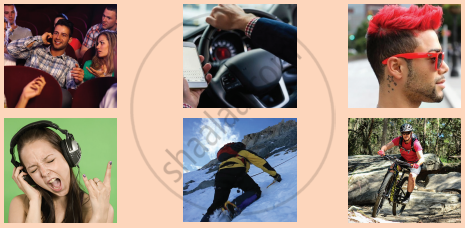Advertisements
Advertisements
Question
Why does the author advise removing cream from the milk?
Solution
The cream should be removed before adding the milk to tea because creamy milk gives a sickly taste to the tea.
APPEARS IN
RELATED QUESTIONS
Why didn’t the boys disclose their problem to the author?
Justify the title of the story ‘Two Gentlemen of Verona’
What seems ‘curious’ to the author?
Why does the author say that it is important to include a tea recipe in cookery books?
Mention the countries in which tea is a part of civilization.
Does the author like drinking tea with sugar? Give reasons.
Summarise George Orwell’s distinctive ideas in “A Nice Cup of Tea”.
There are several physically-challenged people who have lived successful and meaningful lives. Here are a few personalities who have fought great odds and lived a life of blazing achievements. Let’s share what we know about each of them and complete the table below.
| Name of the personality | Nature of challenge | Field of achievement |
| e.g. Beethoven | Hearing impairment | Music |
| Demosthenes | ||
| Helen Keller | ||
| Mariyappan Thangavelu | ||
| Mozart | ||
| John Milton | ||
| Sudha Chandran |

What thoughts troubled Dr. Christiaan Barnard as he neared the end of his career as a heart surgeon?
What roles did the duo take up?
What happened when the doctor couple were crossing the street?
How did a casual incident in a hospital help Dr. Barnard perceive a new dimension of life?
Adventures, expeditions, and explorations are always exciting. Especially when they are real and if it is the first of its kind, it is even more thrilling. The only question that comes to one’s mind is what makes one to take up such tasks that involve high risks. It is the spirit of formidable adventure and certain qualities which make them achieve such feats.
What did Hillary mean by saying “We had had enough to do the job, but by no means too much”?
What did the photograph portray?
Describe the stool that the narrator’s family had.
How did Maamanaar handle the chair at home?
Why did Maamanaar hand over the chair to the villagers to retain it?
Narrate the humorous incidents that happened in the author’s home before and after the arrival of the chair.
From the pictures given below, identity the actions that may cause inconvenience and discomfort to others. Discuss.

According to the author, what are we more conscious of?
What is the foundation of social conduct?
Para 1
We started up our cooker and
drank large quantities of lemon juice and
sugar, and followed this with our last tin of
sardines on biscuits. I dragged our oxygen
sets into the tent, cleaned the ice off them,
and then rechecked and tested them.
Para 2
I had removed my boots, which
had become wet the day before, and they
were now frozen solid. So I cooked them
over the fierce flame of the Primus and
managed to soften them up. Over our
down clothing, we donned our windproof
and onto our hands, we pulled three pairs
of gloves – silk, woollen, and windproof.
Para 3
At 6.30 a.m. we crawled out of that
tent into the snow, hoisted our 30 lb. of
oxygen gear on to our backs, connected
up our masks and turned on the valves to
bring life-giving oxygen into our lungs. A
few good deep breaths and we were ready
to go. Still a little worried about my cold
feet, I asked Tenzing to move off.
How did Hillary and Tenzing prepare themselves before they set off to the summit? (Para 1, 2, and 3)
Para 15
For a few moments, I lay regaining
my breath, and for the first time really
felt the fierce determination that nothing
now could stop us from reaching the top. I took
a firm stance on the ledge and signaled
to Tenzing to come on up. As I heaved
hard on the rope, Tenzing wriggled his
way up the crack, and finally collapsed at
the top like a giant fish when it has just
been hauled from the sea after a terrible
struggle.
Para 16
The ridge continued as before:
giant cornices on the right; steep rock
sloped on the left. The ridge curved away
to the right and we have no idea where the
top was. As I cut around the back of one
hump, another higher one would swing
into view. Time was passing and the ridge
seemed never-ending.
Para 17
Our original zest had now quite
gone, and it was turning more into a grim
struggle. I then realized that the ridge
ahead, instead of rising, now dropped
sharply away. I looked upwards to see a
narrow snow ridge running up to a snowy
summit. A few more whacks of the ice-ax
in the firm snow and we stood on top.
The ridge had taken us two and half hours, but it seemed like lifetime. Why? (Para 15 to 17)
Para 19
neighbour Makalu, unexplored and
unclimbed. Far away across the clouds,
the great bulk of Kanchenjunga loomed
on the horizon. To the west, we could
see the great unexplored ranges of Nepal
stretching off into the distance.
Para 20
The most important photograph,
I felt, was a shot down the North Ridge,
showing the North Col and the old route
which had been made famous by the
struggles of those great climbers of the
1920’s and 1930’s. After ten minutes,
I realized that I was becoming rather
clumsy-fingered and slow-moving. So I
quickly replaced my oxygen set
Describe the view from the top. What was the most important photograph? (Para 19 and 20)
‘There is no height, no depth that the spirit of man, guided by higher Spirit cannot attain’. Discuss the above statement in the context of the achievement of Edmund Hillary and Tenzing.
